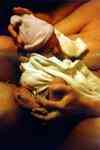Mum
seeks second water birth in Shanghai
Saturday, March 26, 2005
Hu Yan
CHINA DAILY
SHANGHAI: The first woman in China who gave birth using the deep-water immersion method is preparing to set a new record.
Ma Nan is planning to repeat her first water-borne delivery with her second child - but this time her family will join her in the pool.
Ma's American husband, and their son - who was born underwater two years ago and whom we cannot name - will join mum to help her feel more relaxed.
"With her family members joining her in the birthing pool, Ma Nan will feel more relaxed and confident," said Dr Rong Jian, director of the Administrative Office of Shanghai Changning District Maternity and Child Health Hospital.
Twenty-nine-year-old Ma is a university teacher in Beijing. But she could not find a hospital in the capital that offered a birthing pool when she first got pregnant in 2003. "With her second child due in September, she will again seek help from the Shanghai hospital," said Rong.
Ma and her American husband had their first child using the method on March 1, 2003.
According to a medical journal, community midwives have for decades encouraged women to have a warm bath during labour, but it was only when, in 1977, Dr Michael Odent installed an inflatable pool in his hospital in Pithiviers, France, that water birth became more widely known to the public.
Women choose this option primarily because of the remarkable pain relieving benefits and the freedom of movement it allows. They tend to enter the pool when labour is well under way since water can slow early labour down, and may stay there until after the baby is born.
Water in the pool is maintained at 36 or 37 degrees Celsius, said Dr Rong, and the cost for this special service is around 700 yuan (US$84) higher than natural birth - but much less than Caesarean birth.
"A water birth not only relieves labour pain, but also helps reduce the chance of infection and can shorten the labour process by some two hours," said Rong.
"The pain of labour can be harrowing for the mother, but may also leave a painful memory for the infant," said Barbara Harper, founder of Waterbirth International, during the Shanghai International Labour Technique Training seminar, which closed this week.
"China is the 71st country to have adopted this midwifery practice," said Harper. And the Shanghai hospital is so far the only one in China to offer the service.
In the past three years, 320 women have delivered their babies in the hospital's labour pool. All were successful. Not a single case of infection was reported.
But the practice is still too controversial for many Chinese women, who tend to see labour as a difficult medical process.
"I wouldn't choose water birth because it sounds unfamiliar," said Hong Lu, a local woman who is three months pregnant.
But medical professionals have shown more enthusiasm. According to Dr. Rong, a survey of some 100 midwives from around the country, who were present at the training sessions, revealed over 90 per cent of them supported the practice.
If this proves true, it may be water babies will soon be an image not confined to mythological tales.
Original Article at China Daily

